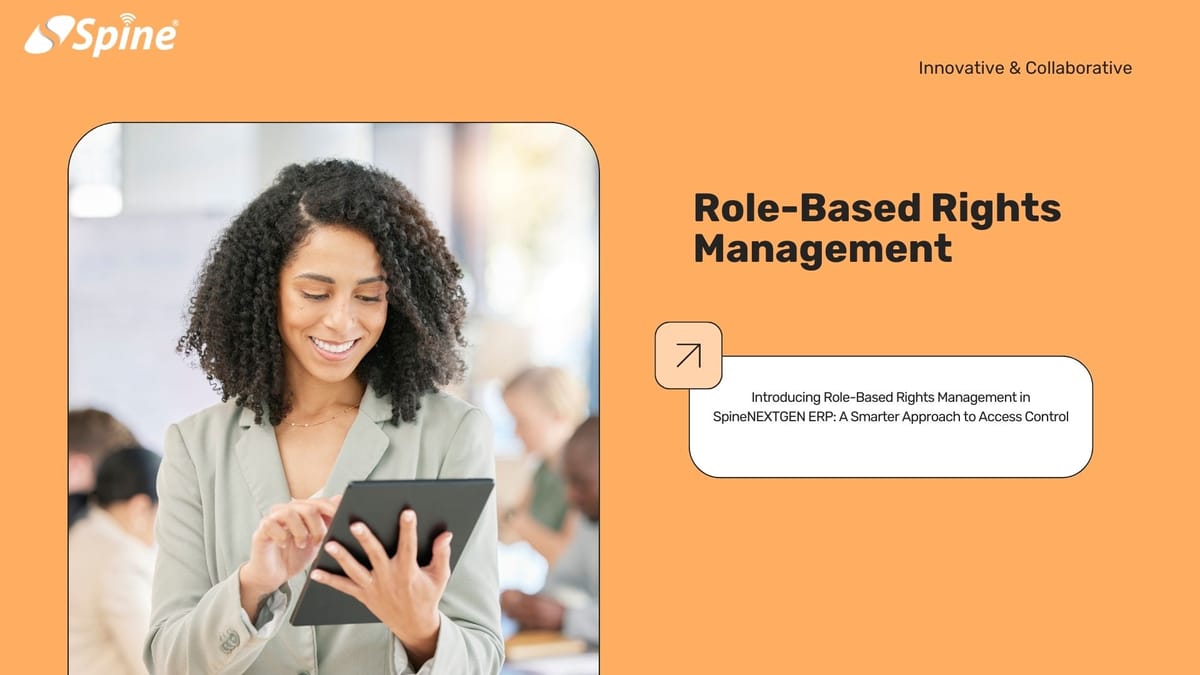Introducing Role-Based Rights Management in SpineNEXTGEN ERP: A Smarter Approach to Access Control

At Spine Software Systems, we are continuously innovating to ensure that our solutions meet the evolving needs of modern businesses. In our latest update to SpineNEXTGEN ERP, we have implemented a significant improvement in how user rights and permissions are managed. Previously, access control in the ERP system was based on organizational hierarchy (organogram), but with this update, we’ve transitioned to a more efficient and flexible Role-Based Rights Management System.
This enhancement will allow businesses to better control access, streamline operations, and improve overall security. Let’s dive into the benefits and how this feature transforms your SpineNEXTGEN ERP experience.
From Organogram-Based to Role-Based Access: What’s the Difference?
Organogram-Based Access Control (Before)
In the previous version of SpineNEXTGEN ERP, permissions were assigned based on an employee’s position within the organization’s hierarchy (organogram). While this worked for traditional structures, it had several limitations:
- Limited Flexibility: Employees' roles could overlap across different departments, yet the system could only assign access based on their place in the organizational chart.
- Administrative Burden: Changes in staff roles or team structures often required manual adjustments to access rights, leading to inefficiencies.
- Potential Security Gaps: Employees might be granted access to sensitive information simply because of their hierarchical position, even if their role didn’t require it.
Role-Based Access Control (Now)
With Role-Based Rights Management, we’ve taken a more refined approach to access control. Rather than assigning permissions based on an employee’s place in the organizational chart, access is now tied to their specific job role. This allows administrators to define access permissions based on the actual functions and responsibilities associated with a user’s role, offering greater flexibility and precision.
Key Benefits of Role-Based Rights Management
1. Enhanced Flexibility
One of the biggest advantages of Role-Based Rights Management is its ability to provide flexible access control. Users can now be assigned multiple roles based on their responsibilities, regardless of their position in the organization’s hierarchy. This means that employees working across departments or on special projects can have tailored access to the data and tools they need without having to change their position within the ERP system.
Example:
An employee in the Finance department may also need temporary access to reports in the HR system due to cross-functional project involvement. With Role-Based Rights Management, this can be achieved without altering the employee's core position in the ERP hierarchy.
2. Improved Security
Security is paramount in any ERP system, and role-based access provides an added layer of protection by ensuring that employees only have access to the data and features relevant to their job functions. This “least privilege” approach limits the exposure of sensitive information, reducing the risk of unauthorized access and potential data breaches.
Key Security Enhancements:
- Granular Access Control: Administrators can assign specific rights for each role, allowing fine-tuned access down to individual features, modules, or datasets.
- Role-Specific Permissions: Employees can only view, edit, or manage the information directly related to their roles, limiting the potential for accidental or intentional misuse of sensitive data.
3. Streamlined Management and Efficiency
For businesses with dynamic teams and evolving structures, managing access rights can be time-consuming. The new role-based system reduces the administrative burden by allowing easier role assignment and centralized control. Instead of adjusting permissions for each user when they change roles or responsibilities, administrators can simply assign a new role or modify existing ones.
Key Efficiency Improvements:
- Scalability: As your business grows, it’s easier to manage user rights by assigning predefined roles rather than adjusting permissions manually for each user.
- Simplified Role Updates: If a role’s responsibilities change, administrators can update the permissions for that role, and the change will automatically apply to all users assigned to that role.
4. Consistent and Clear Access Rights
Role-based management ensures consistency across the board. Since each role is predefined with a specific set of permissions, there is no ambiguity regarding what level of access each employee has. This creates clear boundaries and helps to ensure that employees only interact with the parts of the ERP system that are relevant to their work.
Benefits of Consistency:
- Reduced Errors: With clear role definitions, employees are less likely to make mistakes by accessing modules they are unfamiliar with or shouldn’t have access to.
- Better Oversight: Managers and administrators can easily audit user access, ensuring compliance with internal policies and regulatory requirements.
How Role-Based Rights Management Works in SpineNEXTGEN ERP
1. Defining Roles:
In SpineNEXTGEN ERP, administrators can create predefined roles, each with specific access levels and permissions. For example, roles such as "Finance Manager," "Sales Executive," "HR Administrator," or "Project Leader" can be created, each with tailored access to the relevant ERP modules.
2. Assigning Roles to Users:
Users are then assigned roles based on their responsibilities. A user can have one or more roles, depending on the scope of their work. This flexibility ensures that individuals have all the access they need without overextending permissions.
3. Modifying Roles as Needed:
As the organization grows or as responsibilities shift, administrators can easily modify roles or create new ones. These changes are instantly applied to all users assigned to the updated roles, ensuring seamless transitions and improved workflow efficiency.
Final Thoughts
The transition from organogram-based to Role-Based Rights Management in SpineNEXTGEN ERP marks a significant leap forward in access control and security. By providing more granular, flexible, and secure access to ERP modules and data, businesses can now optimize both their operational efficiency and their security posture. Whether you're a small business or a large enterprise, this feature allows for more tailored, controlled, and efficient management of user access.
